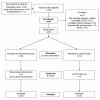Nordic walking improves daily physical activities in COPD: a randomised controlled trial
- PMID: 20727209
- PMCID: PMC2933683
- DOI: 10.1186/1465-9921-11-112
Nordic walking improves daily physical activities in COPD: a randomised controlled trial
Abstract
Background: In patients with COPD progressive dyspnoea leads to a sedentary lifestyle. To date, no studies exist investigating the effects of Nordic Walking in patients with COPD. Therefore, the aim was to determine the feasibility of Nordic Walking in COPD patients at different disease stages. Furthermore we aimed to determine the short- and long-term effects of Nordic Walking on COPD patients' daily physical activity pattern as well as on patients exercise capacity.
Methods: Sixty COPD patients were randomised to either Nordic Walking or to a control group. Patients of the Nordic Walking group (n = 30; age: 62 +/- 9 years; FEV1: 48 +/- 19% predicted) underwent a three-month outdoor Nordic Walking exercise program consisting of one hour walking at 75% of their initial maximum heart rate three times per week, whereas controls had no exercise intervention. Primary endpoint: daily physical activities (measured by a validated tri-axial accelerometer); secondary endpoint: functional exercise capacity (measured by the six-minute walking distance; 6MWD). Assessment time points in both groups: baseline, after three, six and nine months.
Results: After three month training period, in the Nordic Walking group time spent walking and standing as well as intensity of walking increased (Delta walking time: +14.9 +/- 1.9 min/day; Delta standing time: +129 +/- 26 min/day; Delta movement intensity: +0.40 +/- 0.14 m/s2) while time spent sitting decreased (Delta sitting time: -128 +/- 15 min/day) compared to baseline (all: p < 0.01) as well as compared to controls (all: p < 0.01). Furthermore, 6MWD significantly increased compared to baseline (Delta 6MWD: +79 +/- 28 meters) as well as compared to controls (both: p < 0.01). These significant improvements were sustained six and nine months after baseline. In contrast, controls showed unchanged daily physical activities and 6MWD compared to baseline for all time points.
Conclusions: Nordic Walking is a feasible, simple and effective physical training modality in COPD. In addition, Nordic Walking has proven to positively impact the daily physical activity pattern of COPD patients under short- and long-term observation.
Figures




References
-
- Rabe KF, Hurd S, Anzueto A, Barnes PJ, Buist SA, Calverley P, Fukuchi Y, Jenkins C, Rodriguez-Roisin R, van Weel C, Zielinski J. Global strategy for the diagnosis, management, and prevention of chronic obstructive pulmonary disease: GOLD executive summary. Am J Respir Crit Care Med. 2007;176(6):532–55. doi: 10.1164/rccm.200703-456SO. - DOI - PubMed
-
- Pitta F, Breyer MK, Hernandes NA, Teixeira D, Sant'Anna TJ, Fontana AD, Probst VS, Brunetto AF, Spruit MA, Wouters EF, Burghuber OC, Hartl S. Comparison of daily physical activity between COPD patients from Central Europe and South America. Respir Med. 2009;103(3):421–6. doi: 10.1016/j.rmed.2008.09.019. - DOI - PubMed
Publication types
MeSH terms
LinkOut - more resources
Full Text Sources
Medical

